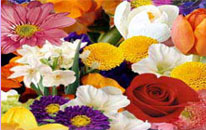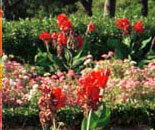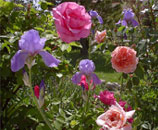| The world famous Valley of Flowers is situated in the upper expan- sions of Bhyundar Ganga in the far int- erior of Garhwal Himalayas. The valley is spread over an area of 87.5 Sq. Kms. And is 3,250 mt to 6,750 mt. Above the mean sea level. The rich references of this colouful and eye catching Valley, are found in the animals of Indian History and literature like that of Ramayana and Mahabharat. The rich references of this colouful and eye catching Valley, are found in the animals of Indian History and literature like that of Ramayana and Mahabharat.But due to its near inaccessible approach it had disappeared from the tourists map until in 1931 when Franksmith a British mountaineer having lost his way while returning from ssuccessful expeditionto mt. Kamat, reached this valley which was full of flowers.He was overwhelmed by its enchanting beauty and named it as “ Valley of Flowers".
The valley of Flowers National Park starts from Ghangharia but the main valley starts after crossing the gorge and the stream starting from nar Parvat, 3 Kms. Away from the Ghangharia. In the front of the Valley stands and snowclad peak of Ratban Parvat and at the block is the kunt Khal, towards the left is Nar Parvat which separates the Badrinath valley from this valley and in the right hill is the dense Birch forest.
Below the forest is the meadow. River pushpavati flows through the valley and there are many aterfalls enhancing the beauty of the valley. The splendour and the scintillating beauty of the valley attracts tourists from all over the world.
The bloom starts immediately after the melting of snow but the peak blooming period is from mid July to mid of August. Almost 300 species of wild flowers bloom here in natural way. Wherein some of the species areAnemone, Geranium, Marsh marigold, Prinula, Potentilla, Geum, Asters, Lilium, Ranunculus, Corydalis, Inula, Braham kamal, Campanula, Pedicularis, Arisaema, Morina, Impatiens, Bistorta, Ligularia, Anaphalis, Saxifrages, Sibbaldia,
Thermo- psis, Trollius, Codonopsis, Dactylorhiza, Cypripedium, Str- awberry, Epilobium, Rhododendrons and numerous others. Most of the flowers have medicinal values too. The abundance of Asmanda fern in this valley is a rare sight than in other Himalayan valleys. The valley remains is bloom for three months while the looral composition keeps on changing every few days. By September the hue starts changing and autumn bids farewell to flowers and the entire vegetation remains dormant for about next five months when the valley is snow bound.
Apart from the flowers some species of Butterfly, Musk deer, Blue sheep ( Bharal ), Himalayan bear, Himalayan mouse hare and some Himalayan birds & Snow leopard are also found in this area. Due to these specialities it has always caught the attention of the nature lovers as well as the environmentalists. To conserve the nature’s benevolent gift and to maintain the natural balance of the valley-the valley was declared a National Park in 1982.
|


